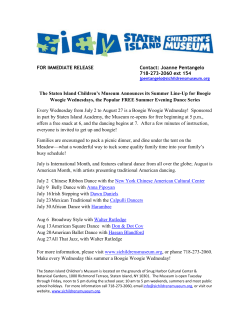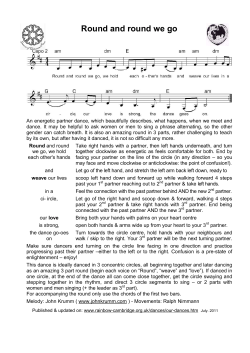
HOW TO DANCE WITH ART – ON THE INTERFERENCE OF
HOW TO DANCE ON THE INTERFERENCE OF WITH ART – TIME-BASED ARTS AND ART SPACES For quite some time now, visitors to contemporary exhibitions have encountered dancing, humming, speaking or sweating bodies that confront the object centricity of the museum in diverse performance formats. This tendency towards “bringing to life” the museum through performance art and live art is thanks to the influence of neo-/avantgarde demands in the 20th century for an ‘extension of the arts’ (electively into ‘life,’ into the non-artistic or into various art genres). This has effectively resulted in a series of new forms and genres that are distinguished most of all by characteristically being performative and hybrid. Criticism of art institutions – most of all, of the museum – has belonged to the recurring rhetoric of this search for transgression. A glimpse at the contemporary art scene reveals a tendency towards performative formats in the museum business. In exhibitions such as “I promise it’s political” (Cologne 2002), “Das lebendige Museum” (Frankfurt am Main 2003), “The Impossible Theatre” (London, Warsaw, Vienna 2005), “The World as a Stage” (London 2007), “rétrospective” (Barcelona 2012) or “Eleven / Twelve / Thirteen /Fourteen Rooms” (Manchester, Essen, Sydney, Basel 2011 –2014), dance, performance or live art artists such as Xavier Le Roy, La Ribot or Jérôme Bel not only carry out performances in museum space, but they also design and perform entire exhibitions. If institutions such as London’s Tate Modern opens a temporary performance space – The Tanks – for ‘Art in Action’ and Boris Charmatz founds a consistently emerging Museé de la danse, it seems appropriate to contemplate the relationship of temporal and spatial dimensions of art, and further, to question the role of the audience: How can time-based works of art be conceived, produced and collected for and by museum spaces? Which gaps or shifts in perception result? And how great a role does the temporal framework of the museum or theatre play in the reception and evaluation of these performances? These questions have been taken up by the Foreign Affairs Festival 2014 as an occasion to ask artists, curators and academics to reflect together on the production, presentation and reception of contemporary live art formats. EIGN AIRS –13.7.14 MUSÉE DE LA DANSE , which was initiated by Boris Charmatz in 2009, has its roots in his directorship of the Centre choréographique national de Rennes et de Bretagne that began in 2009, and the initial renaming act. Proceeding from the question of how one sets up a productive relationship between the ephemeral, proliferating nature of dance and the static, fixed and long-lasting nature of museums, Charmatz explores the interlacing of performance, dance, the visual arts and theory in several projects. A central goal of this project is the “idea of creating a new public space for – and by – dance” (Charmatz). The “experimental assemblages” (Noémie Solomon) that have resulted are made up of exhibition projects such as “éxpo zéro” (various venues 2009 –2011, 2014), “brouillon” (Rennes 2010, Brussels 2013) or the “The Artist Lab” as part of “Moments. An Exhibition of Performance in 10 Acts” (Karlsruhe 2012), dance pieces and projects that are performed in parks, museums or libraries (“Levée des conflits” 2010 –2014, “20 dancers for the XX century” 2012 –2014) as well as more object-based exhibitions (“Photo” 2012) and dance workshops. Along this route, a travelling museum is formed that temporarily settles at festivals or in art spaces like the Argos Art Center in Brussels, the ZKM Karlsruhe, the MoMA in New York or the Berliner Kunstsaele. In the later – such as in the format “expo zéro” – a collective of architects, philosophers and performers are invited to fill the empty spaces for several days with thoughts, gestures and actions proceeding from their personal answers to the question: What would a museum of dance be for you? One crucial aim of such a “’performative form’ of discussion” (Charmatz) and other related formats is to confront the inherent contradiction in dance’s ephemeral nature and the durability of museums with alternative models of time. This includes performances such as “étrangler le temps” (2009) and “Levée des conflits” (2010 –2014), in which moments of time extension and endless repetitions are worked on, as well as the dance pieces “Flip Book” and “20 dancers for the XX century” (Rennes 2012; New York 2013; Berlin 2014) and “50 years of dance” (including Paris, Vienna 2009), in which forms of movement from 20th century cultural history are re-performed with fragments from dance and performance art. This is done by applying a specific temporal modus for each piece – as solos performed in a loop, for example, or formats resembling a flip-book. Not least of all, the fascination of the Musée de la danse lies in how – through persistent questions, new creations and by docking onto the most diverse kinds of institutions and public spaces – practical and conceptual resistance between the fields of the arts surfaces and can be incorporated. Or in the words of Boris Charmatz: “One of the particularities of this museum is to integrate forms of rejection.” FORE AFFA 26.6. Barbara Gronau & Jan Dammel 2 JULY 2014 SYMPOSIUM PROGRAMME 17:00 Welcome by Matthias von Hartz & Barbara Gronau 17:10 Lecture by Dorothea von Hantelmann on different modalities and economies of time in the visual and the performing arts and their formats such as exhibition and performance 17:30 Talk: La Ribot & Christian Falsnaes, chaired by Jörn Schafaff on the relationship between exhibiting and performing 18:30 Talk: Catherine Wood & Katleen van Langendonck, chaired by Jörn Schafaff on the significance of institution and audience at the intersection of visual and performing / time-based arts 19:30 end of first part 20:00 Boris Charmatz “Levée des conflits” (Ticket Office: downstairs, ticketinfo@berlinerfestspiele.de, ph.+49 30 254 89 100) EIGN AIRS –13.7.14 FORE AFFA 26.6. 21:45 Artist-Talk: Boris Charmatz & Franz Anton Cramer on the “Musée de la danse” and the works presented in the festival Participants: BORIS CHARMATZ Dancer and choreographer Boris Charmatz is well known for works including “Aatt enen tionon” (1996) and “enfant” (2011). While maintaining an extensive touring schedule, he also participates in improvisational events on a regular basis and continues to work as a performer (with Anne Teresa De Keersmaeker and Tino Sehgal). Director of the Rennes and Britanny National Choreographic Centre since 2009, Boris Charmatz has transformed the centre into a Musée de la danse – a dancing museum. Projects to date include “préfiguration”, ”expo zéro”, ”héliogravures”, ”rebutoh”, ”service commandé” (on commission), “brouillon” (rough draft), “Jérôme Bel en 3 sec. 30 sec. 3 min. 30 min et 3 h”. Charmatz was associate artist at the 2011 Festival d’Avignon, he was invited at MoMA (New York) in 2013 for “Musée de la danse: Three Collective Gestures“. FRANZ ANTON CRAMER is Senior Researcher at the Inter-University Centre for Dance / Universität der Künste, Berlin, where he co-directed the BA-course “Contemporary Dance, Context, Choreography“ from 2007 till 2010, together with Gisela Müller and Boris Charmatz. 2004 to 2006 he was Researcher in residence at the Centre National de la Danse near Paris and between 2007 and 2013 a Fellow at the Collège International de Philosophie in Paris. Together with Barbara Büscher he founded the e-journal “MAP — Media Archive Performance” in 2009. CHRISTIAN FALSNAES born 1980 in Copenhagen, lives and works in Berlin. Educated at the Academy of Fine Arts, Vienna. Selected exhibitions include Art Basel, “Statements” with PSM / “Vertigo of reality”, Akademie der Künste, Berlin / “Formations of bodies”, KW Institute of Contemporary Art, Berlin / “Ihre Geschichten”, Bonner Kunstverein, Bonn / “Grundfrage”, Crac Alsace, Altkirch / “Entweder/oder”, Haus am Waldsee, Berlin / “ACTS”, Museum of Contemporary Art, Roskilde, Denmark / “ELIXIR”, PSM, Berlin. DOROTHEA VON HANTELMANN born in 1969 in Hamburg, is documenta professor at Kunsthochschule / University of Kassel. The main focus of her research is contemporary art and the social function of art exhibitions. Among her recent publications are “How to Do Things with Art: The Meaning of Art’s Performativity“ (2010) and “Die Ausstellung. Politik eines Rituals“ (ed. with C. Meister, 2010). JÖRN SCHAFAFF is a Research Associate at the Colla- borative Research Centre “Aesthetic Experiences and the Dissolution of Artistic Limits” at Freie Universität Berlin. He is currently writing a treatise on “situation” as a concept of artistic presentation and about the relationship between exhibiting and performing. From 2009 to 2010, he contributed to the institution and development of the course “Cultures of the Curatorial” at the Leipzig Academy of Visual Arts. He is the author of “How We Gonna Behave? Philippe Parreno. Angewandtes Kino” (2008) and co-editor of “Cultures of the Curatorial” (2012), “Kunst-Begriffe der Gegenwart” (2013), “Assign & Arrange: Methodologies of Presentation in Art and Dance” (2014) and “Timing: On the Temporal Dimension of Exhibiting” (2014). LA RIBOT born 1962, in Madrid. Early on she becomes an independent choreographer and performer of her own work. With the project “piezas distinguidas”, La Ribot stands out in the international contemporary dance and live art scene, in particular with “13 piezas distinguidas” (1993), “Más distinguidas” (1997), “Still distinguished” (2000) and “Panoramix” (2003). She collaborates with Mathilde Monnier for their duo “Gustavia” (2008) and with other artists for “Laughing Hole” (2006). KATLEEN VAN LANGENDONCK born 1971, studied Germanic Philology / Literature in Leuven and Paris. She worked as a literary critic (for “De Standaard” i.a.) from 1994 until 1997 and was responsible for performing arts programming at deSingel international arts centre in Antwerp from 1997 to 2002. From 2002 to 2007 she had been a member of the academic staff at Antwerp University, where she lectured in dance history and dance analysis, did research on tactility in the performing arts, and co-coordinated the inter-university post-master in Theatre Studies. Since 2007 Katleen Van Langendonck is responsable for the artistic programme of the Brussels performing arts center Kaaitheater, together with Guy Gypens. She has, amongst other projects, initiated Performatik, the Brussels biënnale for performing arts (4th edition: 18 to 28 march 2015), a collaboration with other Brussels institutions from the visual as well as the performance arts field (Argos, Bozar, Wiels amongst others). In cooperation with Barbara Gronau and Jan Dammel (Universität der Künste, Berlin) CATHERINE WOOD is curator of Contemporary Art / Performance at Tate Modern. She co-curated the exhibitions “The World as a Stage” at Tate Modern in 2007, “Pop Life” in 2010 and curated “A Bigger Splash: Painting after Performance” in 2012, as well as co-directing the opening programme for the Tate Tanks in 2012, titled, “Art in Action”. She has programmed numerous performance works at Tate since 2003 including works by Mark Leckey, Joan Jonas, Guy de Cointet, Jiri Kovanda and Sturtevant and initiated the online project, “Performance Room” in 2011. Wood is author of “Yvonne Rainer: The Mind is a Muscle” (2007, Afterall / MIT press) and the forthcoming publication, “Performance in Contemporary Art” (Tate Publishing, due 2015). A regular contributor to “Afterall”, “Artforum” and “Mousse magazines”, she has also written numerous catalogue essays, recently on Joachim Koester, Piotr Uklanski, and Sung Hwan Kim. BARBARA GRONAU is Professor for theory and history of the theatre at the Universität der Künste, Berlin. In 2006, she obtained a PhD at Freie Universität Berlin with a thesis on the interferences of visual art and theatre (“Theaterinstallationen. Performative Räume bei Beuys, Boltanski, Kabakov”, Munich 2011), which received the Joseph Beuys-Award for Research. After working as an associate lecturer at FU Berlin and a guest lecturer at Bern University and others, she was appointed Junior Professor at Düsseldorf’s Heinrich-HeineUniversität. Barbara Gronau has worked as a dramaturg for numerous theatre productions and as curator of various performance festivals at Hebbel am Ufer and Radialsystem Berlin. One of her current research projects is “Standstill – Scenes of stasis and latency in the arts”, a project of the German Research Foundation. JAN DAMMEL is a tutor in the performing arts department at the Universität der Künste, Berlin and a student assistant at the research project “Standstill – Scenes of stasis and latency in the arts”. He is currently reading for a Master’s Degree in Theatre Studies at Freie Universität Berlin; his B.A.-thesis “Dance as sculpture?” investigated temporality in “Levée des conflits”. He worked as a dramaturgy assistant for productions at Hebbel am Ufer Berlin and the Maxim Gorki Theater and most recently as assistant to artists Sarah Van Laamswerde and Ivo Dimchev at the festival Performatik at Kaaitheater Brussels in 2013.
© Copyright 2025










